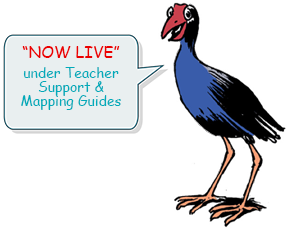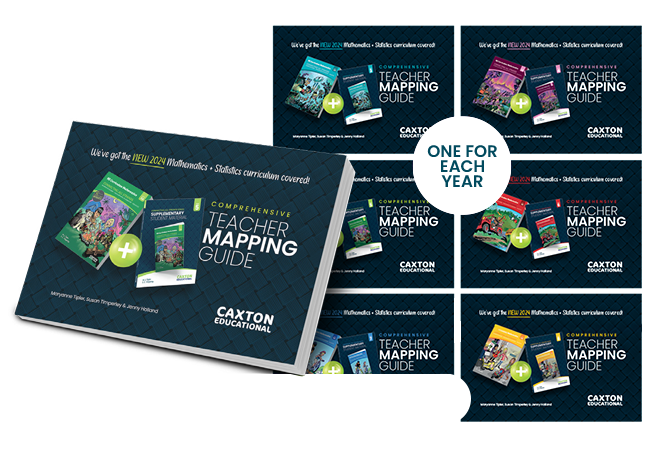Teacher Mapping
Guide
The mapping guides are live in this website.
Login to TEACHER SUPPORT & MAPPING GUIDES to download your mapping guides for each year.
Our comprehensive mapping will tell you exactly which pages in our original main student books and in our supplementary student material books can be used to teach the new 2024 curriculum, for each objective.
- Column one lists the objectives.
- Column two gives page references from our main student book and our supplementary student book.
- Column three lists our online resources. Clicking on those in red takes you directly to an essential Teacher Resource Sheet (TRS) or Extra Task (ET) page. Those in green are not essential but align with the new curriculum and those pages are all in the Teacher Support part in this website.
There are also extensive Notes to Teachers.
SAMPLE ONLY

Measurement - Perimeter, area and volume
Teach students to
Connecting All Strands Year 6 (3B) and supplementary material references (NC6-…)
visualise, estimate, and calculate the area of rectangles and right-angled triangles (in cm2 and m2) and the volume of rectangular prisms, by applying multiplication
Book Year 6 (3B)
Chapter 12
Page 209
(whole chaper)
(perimeter, area, volume)
(whole chaper)
(perimeter, area, volume)
NC6-56 to 58
(areas of rectangle and squares and right-angled triangles using the formula and multiplication)
(areas of rectangle and squares and right-angled triangles using the formula and multiplication)
Objectives The teacher mapping guide for each year is set out objective by objective.
Pages in our Connecting All Strands main book that can be used to teach the 2024 curriculum. Pages in our Supplementary Student Book. NC6 stands for New Curriculum Year 6.
... continued ... Measurement - Perimeter, area and volume
Go to www.caxed.co.nz and click on ‘teacher support’ to find the resources in this column
Book Year 6 (3B)
Chapter 12
TRS 91, 92, 93
ET 1, 2, 5, 6
ET 7 More perimeter area and volume problems
References to relevant online material are listed especially teacher resource sheets and extra tasks. Clicking on the red text takes you directly to that resource page.
Measurement - Perimeter, area and volume
Teach students to
Connecting All Strands Year 6 (3B) and supplementary material references (NC6-…)
Go to www.caxed.co.nz and click on ‘teacher support’ to find the resources in this column
visualise, estimate, and calculate the area of rectangles and right-angled triangles (in cm2 and m2) and the volume of rectangular prisms, by applying multiplication
Book Year 6 (3B)
Chapter 12
Page 209
(whole chaper)
(perimeter, area, volume)
(whole chaper)
(perimeter, area, volume)
NC6-56 to 58
(areas of rectangle and squares and right-angled triangles using the formula and multiplication)
(areas of rectangle and squares and right-angled triangles using the formula and multiplication)
Book Year 6 (3B)
Chapter 12
TRS 91, 92, 93
ET 1, 2, 5, 6
ET 7 More perimeter area and volume problems
Objectives The teacher mapping guide for each year is set out objective by objective.
Pages in our Connecting All Strands main book that can be used to teach the 2024 curriculum. Pages in our Supplementary Student Book. NC6 stands for New Curriculum Year 6.
References to relevant online material are listed especially teacher resource sheets and extra tasks. Clicking on the red text takes you directly to that resource page.
Notes to teachers
1. Use the material in the order in which it is listed in column two.
2. Point out the link to multiplication when calculating areas as a number of rows of squares and remind students that they can multiply in any order (commutative property).
3. Give students lots of practical measuring situations and connect:
- finding area with multiplication arrays
- finding area and volume with the commutative property of multiplication
- how part-units can be combined using number concepts, when finding the area of a shape
4. Encourage students to have clear laid out working when calculating perimeter, area and volume. This particularly important when calculating for complex shapes to ensure that they include all required parts of the shapes.
For sheets NC6–56 to 58
1. Connect the area of a right-angled triangle with half the area of a square or rectangle.
2. These pages use the formulae for area of a rectangle, square and right-angle triangle to find the area.
Relate the formula back to counting squares and why the formula works. The practical on NC6-57 can be used to show this. It is important that students understand where the formula comes from rather than just learn it by rote.
Relate the formula back to counting squares and why the formula works. The practical on NC6-57 can be used to show this. It is important that students understand where the formula comes from rather than just learn it by rote.
3. Remind students to always put units with their answer. Sometimes students don’t put the exponent on the units so for example m instead of m2. The units are squared because two lengths are being multiplied together and so the units are also multiplied together.
Teaching notes are given in the mapping.


